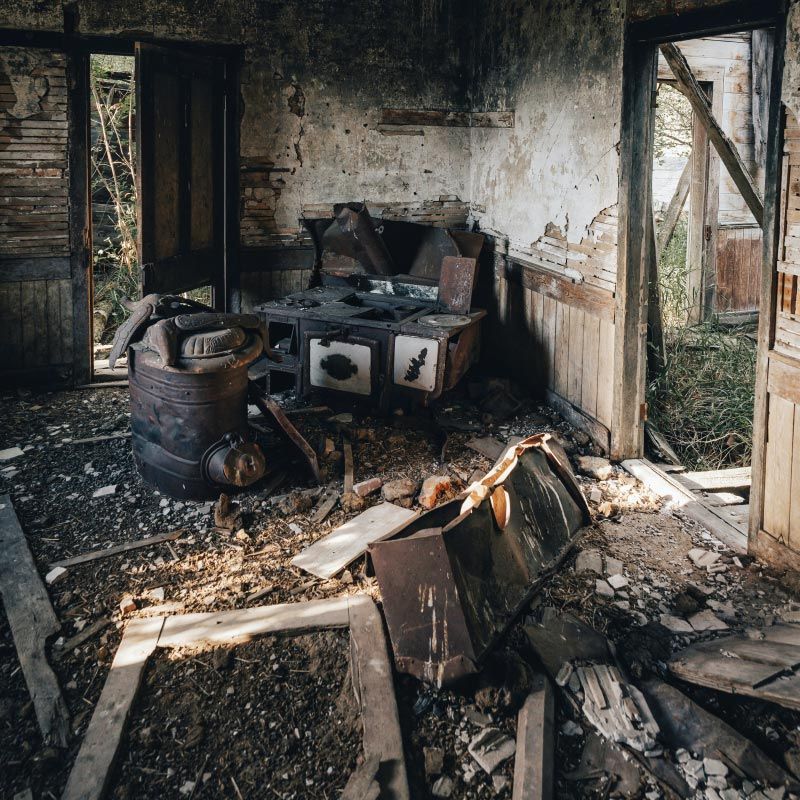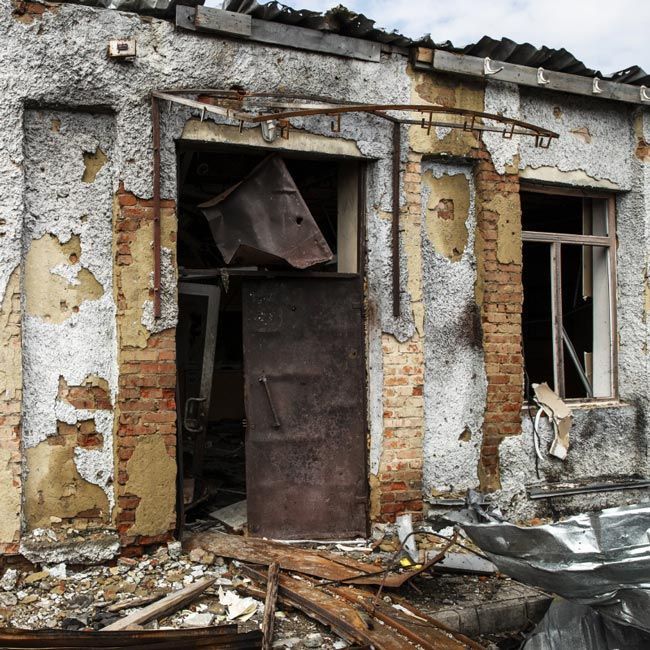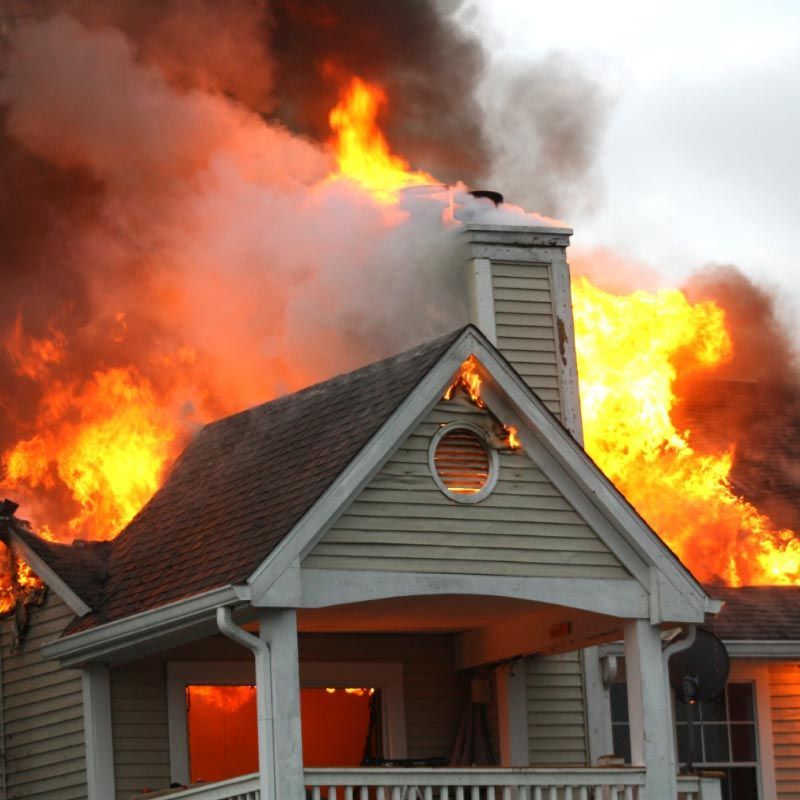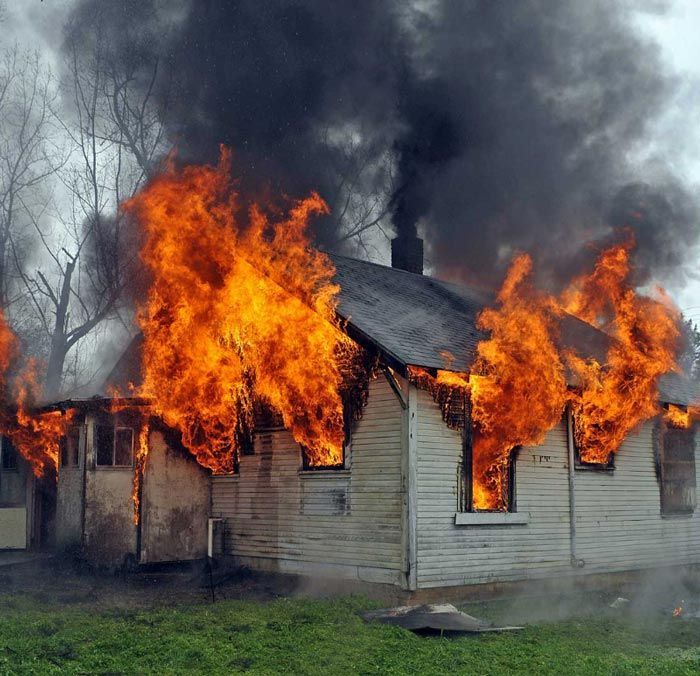How Much Does Fire Damage Restoration Cost? [2023 Guide]
Free Offer Form
We will get back to you as soon as possible.
Please try again later.
Selling a fire damaged house is possible, though may be difficult with a real estate agent. Selling as-is to a National cash buyer is one of the best options. Fill out the form below to get started and find out what your property is worth.
Welcome to an in-depth examination of a key topic in the aftermath of fire incidents: this guide seeks to answer the question, "How much does fire damage restoration cost?".
This thorough guide seeks to clarify the complex factors that affect how much it ultimately costs to restore a fire-damaged house.
We'll examine multiple aspects to provide a better idea of the costs and services involved, from damage assessment to services and home insurance coverage considerations.
Exploring Fire Damage Restoration
Exploring fire repair is essential when considering selling your fire-damaged property, as it can greatly affect its marketability and value.
This section will clarify the processes involved in repairing fire damage.
What is Fire Damage Restoration
Fire damage restoration is a procedure that involves repairing and restoring personal property damaged by fire, addressing the damage, and restoring functionality and appearance.
It involves cleaning, repairing structures, deodorizing, and ensuring the building meets safety and building code standards.
The Process of Fire Damage Restoration
Professionals employ various restoration methods during rebuilding after fire to restore the property to its pre-fire condition. Here's an overview of the process.
- Assessment and Inspection: Professionals evaluate the areas affected by the fire, determine the extent of damage, and identify potential safety hazards.
- Securing the Property: If needed, the property is secured to prevent further damage or unauthorized access.
- Water Removal: If water is used to extinguish the fire, it must be removed promptly to prevent mold growth, drywall disintegration, and further damage.
- Smoke and Soot Cleanup: Professionals use specialized techniques and cleaning agents to treat smoke damage and remove the smoke residue safely.
- Odor Removal: Smoke damage from house fires can leave lingering smells. These smells can be eliminated with deodorizing methods like ozone treatments and thermal fogging. Thermal fogging treatment uses a deodorizing agent to mist furniture and textiles.
- Fire Structural Repairs: Damaged structures are repaired or replaced depending on the severity of the damage. After a fire, rebuilding may include the walls, floors, ceilings, and roof.
- Content Restoration: Personal belongings affected by house fires are evaluated and restored when possible.
- HVAC Cleaning: A (HVAC) system can spread smoke and oily soot throughout a property, necessitating air duct cleaning. Cleaning the vents and air ducts may require thermal fogging.
- Final Inspection: A final inspection ensures that all repairs and restoration work meets safety and quality standards.
- Insurance Claims: Throughout the process, documentation is crucial for insurance claims. Keeping records of the damages, repairs, and costs can help facilitate claims with your insurance company.
Prompt fire restoration requires experienced professionals to minimize further damage and ensure a safe living or working environment.
The Importance of Fire Damage Restoration
Fire damage restoration is essential for safety and health, preventing further damage, preserving possessions, settling insurance claims, and facilitating faster recovery.
Professionals handle various aspects of the restoration process, including soot removal, cigarette smoke remediation, and repairs. They can also remove trapped smoke odors.
Swift restoration can minimize costs and provide emotional support to those affected by the house fire.
The extent and quality of damage restoration can have an
impact on property values post-fire, influencing potential buyers and the overall market perception.
GOOD TO KNOW: A 2010 National Fire Protection Association study revealed that 41% of home fires occur in kitchens (due to a grease fire), causing 15% of deaths and 36% of injuries.
Can I Sell a Fire Damaged House National?
Yes. You can sell a fire-damaged house. However, it may be harder to sell in the local National real estate market in as-is condition. You would have to make repairs and possibly rebuild most parts of your house before a buyer takes interest in the property. Your best option when selling a fire-damaged house is a cash buyer. They buy burned houses as-is so you don't need to spend money on repairs. They'll handle all the cleanups and renovations for you, however, expect that their offer may be below the cash value of your property.
Factors that Influence Fire Damage Restoration Cost
Many variables can influence restoration costs. It's crucial to understand these factors in order to manage the repair process effectively.
Extent of Damage
Property damage restoration costs depend on the extent of the damage, including size, smoke and soot, water damage, affected contents, and repair complexity.
Larger areas require more work, while repairing structural damages is typically more expensive. Smoke and soot damage can also increase costs.
Water damage can lead to mold or waterlogged materials, and complex repairs require specialized skills. Accessibility can also affect how much fire damage restorations cost.
Remediation of Smoke and Soot
Repairing smoke and soot damage can significantly impact costs after a house fire. They spread throughout a building, requiring specialized cleaning techniques like ozone treatment.
Different materials react differently to smoke and soot, requiring more intensive cleaning or possibly replacement. Lingering smoke can cause serious health hazards.
Professionals follow specialized procedures to clean after fire, targeting smoke and soot residue to restore indoor air quality and eliminate lingering odors.
Water Damage Treatment
Water damage treatment can significantly impact the costs of fire damage restorations. Firefighting efforts can cause water to seep into burnt materials, causing additional damage like mold growth, which is a health risk.
Mold growth requires prompt removal. Drying and dehumidification require specialized equipment, and structural inspections are necessary.
Therefore, answering "How much does fire damage restoration cost?" depends on the cleanup cost and extent of the damage, fire-damaged materials, and time required.
Structural Repairs
Structural restorations are crucial for safety and functionality.
They involve repairing or replacing compromised walls, ceilings, supports, and any compromised foundations, windows, or doors. This will typically require specialized engineering knowledge.
Safety compliance and timelines also play a role. The extent of structural damage, complexity of repairs, and required expertise all contribute to the restoration cost.
NOTE: Understanding restoration expenses includes considering electrical fires, which may require specialized repairs and safety measures. Electrical fires can complicate the process.
Cost Breakdown of Fire Damage Restoration
This section properly answers "How much does fire damage restoration cost?" by analyzing the elements contributing to the restoration cost.
Average Prices for Fire Damage Restoration Services
After a small fire, homeowners pay $3,500-$5,000 for repairs. Adding the expense of a new roof or kitchen cabinet restoration can raise the bill to over $40,000.
The national average cost of fire damage repair for a house is $2,500. However, fire damage restoration costs vary widely depending on the type and extent of the damage.
Fire Damage Restoration Cost
- National average cost: $2,500
- Average range: $3,000-$40,000
- Minimum cost: $2,500
- Maximum cost: $46,500
Cost Per Square Foot for Fire Restoration
Fire damage repair costs vary based on the house's square footage and the damage's extent. Homes with more square footage will cost more to repair, accordingly.
It costs approximately $4.70 per square foot to restore a 2,600-square-foot home. Prices range from $4.00-$6.50 per square foot, including cleaning up soot, restoring water damage, and burnt material removal.
Average House Size | Cost Per Square Foot
- 1,000 square foot: $4,250 – $6,000
- 2,000 square foot: $8,500 – $12,000
- 3,000 square foot: $12,750 – $18,000
- 4,000 sq. ft.: $17,000 – $24,000+
Additional Costs in Fire Damage Restoration
Fire damage cleanup costs go beyond a home's square footage. This section covers the additional rebuilding and restoration expenses after a house fire.
Water Damage
Fire extinguishing systems like fire extinguishers or smoke detectors require immediate water restoration services to prevent mold and damage. The cleanup cost ranges from $2-4 per square foot, typically $1,000- $5,000.
Soot and Smoke Damage Restoration
Soot and smoke damage restoration are crucial repair costs. These costs range from $2,000-$6,000.
Expect to pay more for oily soot cleanup due to byproducts of grease fires, while dry soot cleanup costs $400-$700.
Odor Removal
Contamination from chemical substances and odor removal costs can range from $1,000-$3,000. Odor removal can involve either ozone treatments or thermal fogging.
The ozone treatment cost for houses is about $300-$600 per floor. Ozone treatment conveniently breaks down and removes smoke odors directly from the source.
Ozone treatment uses high oxygen levels to break down airborne molecules and bacteria, while thermal fogging uses a deodorizing agent to neutralize odors in hard-to-reach areas.
You may also need smoke removal, which may be covered by your homeowners' insurance policy. Note that smoke removal concentrates more on the remediation of the smell.
Removal of Burnt Materials
A fire restoration company removes burnt material and other potentially broken components before structural restorations, incurring more costs. Estimates range from $60/lb. to a $300-$1,600 flat rate.
Fire restoration contractors also remove unsalvageable items and dispose of them properly.
Chemical Damage Restoration
Professionals typically charge between $600-$2,000 for this service, as fire extinguishers can leave chemical residue behind. This chemical residue can impact indoor air quality if not properly removed.
Fire Damage
Replacing damaged materials and reconstruction costs can range from $2,000-$30,000, with extensive damage costing over $80,000 for upscale kitchens.
NOTE: Complex fires that have caused severe home damage can significantly increase the cost of fire damage restoration.
Structural Damage and Other Costs After a Fire
Structural restorations for a fire-damaged home can cost between $15,000- $25,000 per room. Professionals will also assess the building's structural damage and ensure it's safe
Apart from fire restoration services, your costs may include city permits, inspection, and management fees.
These prices can range from $100 to thousands for major reconstruction projects but can be offset by the cost savings from experienced contractors.
NOTE: Class A fires are prevalent. These fires involve solid materials and combustibles like wood, paper, and plastic. Class B fires occur when flammable liquids catch ablaze, like gas, grease, oil, and oil paints. A Class C fire is typically caused by computers, motors, and appliances.
The Process of Selling Fire Damaged Property to a Cash Buyer
The process of getting a cash offer for a burned house is pretty much the same as any property type. However, it is best if you can contact your home insurance company first before getting an offer for your house after a fire. Your National home insurance company can help assess the extent of the fire damage as well as the repair costs. This can help you decide whether selling a house as-is to a cash buyer is really the right path to take. Once you have decided that you really want to get a cash offer, here are the next steps you should take.
Important note: This doesn't apply to all cash buying companies.
1. Request a Cash Offer
You can easily find cash buyers in your National area by searching online. Once you found a reputable cash buyer, head over to their website to fill out a form or give them a call to ask for a cash offer. Most cash buyers and real estate investors give no-obligation cash offers so you can still ask other cash buying companies how much they can buy your fire-damaged property. If you are unsure about the background of a cash buyer, you can always ask them for proof of their source of funds.
2. Welcome the Cash Buyer into Your Home
The cash buyer or real estate investor may want to check your fire-damaged property for the repairs and improvements it needs, especially its roofing, walls, foundation, etc. You won't have to pay for these repairs when selling a National house to them, but experienced home buyers or real estate investors consider repair costs to make an accurate cash offer.
3. Review the Contract and Sign
Once you accept the cash buyer's offer on your fire-damaged home, they would furnish a sales contract and send it to you electronically. You will be given time to go over the terms and ask questions. After everything is settled, sign the contract to make the deal with the National cash home buyer official.
4. Closing
During closing, expect less paperwork since there are no lenders involved. After you have signed the minimal necessary paperwork and the National deed is transferred to the cash buyer's name, you'll get your cash in your bank account. If you aren't confident attending the closing by yourself, bring a real estate attorney with you.
5. Set Your Preferred Day to Move-Out
If the property has minor fire damage and you are still living in it, communicate to the cash home buyer when you want to move out. This is also a good time to ask for a sale-leaseback agreement if you don't have a place to crash on while you are still looking for a new National home.
How to Reduce the Cost of Fire Damage Restoration
This section explains how property owners can optimize resources while ensuring a thorough and efficient repair process.
Explicit Insurance Coverages
To reduce repair costs, it's essential to understand your insurance policy, which may cover specific types of damage.
Ensure your policy covers structural restorations, content replacement, temporary housing, and additional living expenses.
Document your fire damage insurance claim thoroughly, notify your insurance company promptly, and be aware of policy limits. Some policies may cover temporary repairs to prevent further damage.
Seek claim assistance from the insurance company, consider hiring a public adjuster if your claim isn't handled properly, and compare estimates from multiple fire damage restoration companies.
Selecting the Right Professional Service
Selecting the right professional service can help reduce your restoration bill.
Look around your area for other restoration firms and choose a firm specializing in emergency fire restoration. Before deciding on a company, ask for references and review clear contracts.
Reputable companies focus on essential repairs and avoid unnecessary work. Hiring professionals from the start can prevent additional damage and expenses.
DIY Restoration Methods
Let's talk about do-it-yourself (DIY) restoration methods that can help you save on restoration costs:
- Safety First: Before DIY restoration, wear appropriate gear and assess potential hazards.
- Small-Scale Cleaning: You can clean surfaces using household products like mild soap and water for minor soot and smoke damage. Test a small area first to avoid causing further damage.
- Ventilation: Opening windows and utilizing fans can help ventilate the area and remove strong smoke odors.
- Content Cleaning: Clean and salvage less severely damaged items, like washable fabrics and non-porous objects.
- Carpet and Upholstery Cleaning: Use a vacuum with a HEPA filter to clean rugs and upholstery. You can also rent or purchase carpet cleaning equipment.
- Painting and Patching: DIY painting or patching techniques can be used for small areas of fire-damaged walls or ceilings.
- Air Purifiers: Air cleaners with HEPA filters can improve indoor air quality by capturing airborne particles.
- Avoid Water Damage: Prevent additional water damage by covering exposed openings to prevent rain or moisture from getting in.
- Consult Professionals: While some DIY methods can help mitigate minor damage, consult professional restoration experts for a thorough assessment and advice.
Seeking Professional Help
Following a fire, the complex process of property restoration requires a thorough strategy and the knowledge of experts.
This section covers when you should contact the professionals.
When to Hire a Professional
Professionals are essential for addressing the following:
- Extensive damage
- Structural concerns
- Soot and smoke damage restoration
- Water damage
- Electrical and HVAC systems
- Health and Safety
- Content Restoration
- Insurance requirements
- Preventing DIY mistakes
They have the skills and resources to ensure a thorough restoration and can help you save costs.
Professionals can assess and remediate damage to walls, floors, ceilings, and foundations, handle hazardous materials, salvage and restore belongings, and ensure accurate insurance claims processing.
How to Choose a Reliable Restoration Company
To choose a reliable restoration company, research local companies, check online reviews, and ask for recommendations.
Ensure the company is certified, bonded, and insured. Look for companies with experience in restoration for fire-damaged homes.
Request for references from previous clients to understand their work quality. Request a complimentary consultation to discuss your requirements and get a detailed cost estimate, a timeline, and a contract.
Ensure you communicate clearly, are transparent, and stay professional throughout the process. This will help you choose a company that can handle the job effectively.
Frequently Asked Questions
Do you still have concerns regarding the price for restoration? Check this section for more info on the restoration cost after a fire.
What Are the Steps Involved in Fire Damage Restoration?
Fire restoration typically involves the following steps:
- Assessment: Professionals assess the extent of the damage and create a restoration plan.
- Securing the Property: Measures are taken to prevent further damage, such as boarding up openings.
- Water Removal: Excess water is removed if the firefighting efforts cause water damage.
- Smoke and Soot Removal: Cleaning and deodorizing affected areas to eliminate smoke particles and odors.
- Structural Repairs: Repairing damaged walls, floors, and other structural elements.
- Content Restoration: Repairing and restoring damaged belongings and furniture.
- Odor Elimination: Using specialized techniques to remove lingering smoke odors.
- Final Cleaning: Thorough cleaning of the entire property.
- Restoration and Repairs: Painting, replacing damaged materials, and ensuring the property's functionality.
- Final Inspection: Professionals will assess the restoration work's quality and address any remaining issues.
Properly dealing with house fire aftermath requires a mix of damage assessment, cleaning, repairs, and restoration to restore the property.
How Much Does It Cost to Restore Smoke Damage?
The cost will correlate with the extent of the damage and the repairs needed. Typically, homeowners pay between $2,000 and $12,000 for smoke damage restoration services.
Are Fire Damage Restoration Costs Covered by Homeowners Insurance?
Once you're able, prioritize dealing with insurance adjusters post-fire to assess the extent of the damage and facilitate the processing of homeowners insurance claims for fire damage restoration costs.
Homeowners insurance generally helps cover your home and belongings. Most guidelines include coverages that can help pay to repair fire damage.
Can I Do Fire Damage Restoration Myself?
It's always best to speak to a professional restoration company. They'll evaluate the damage and then move forward based on their findings.
Ultimately, there might be parts of the project you can handle independently, but it's best to start with a specialist. This ensures that the cleanup and repair are done properly.
How Long Does It Take for a Professional to Complete Fire Damage Restoration?
The timeline for restoration completion will depend on the extent of the fire damage and the specific procedures required for a comprehensive restoration process.
Fire cleanup and restoration jobs can take weeks or months due to the damaging nature of the disaster.
Whereas water damage restoration involves mitigating water and drying out the property — a task that can often be completed in days.
Conclusion
Fire damage restoration costs are complex, but calculating these costs is crucial for post-fire rehabilitation. We emphasize the need to completely understand these expenditures.
With this information at hand, property owners are prepared to make decisions that strike a balance between efficiency and fiscal responsibility.
It is crucial to approach the restoration process holistically, considering the financial aspects and the larger ramifications on the property's safety, well-being, and long-term survival.
As a result, we implore individuals to use caution and good judgment during the restoration process to ensure the best possible restoration of their homes and the safety of their financial interests.
National Resources
- Selling a Fire Damaged House National
- Selling Inherited Property National
- Selling a House in Probate National
- How to Sell a House by Owner National
- How to Sell Rental Property National
- Stop Foreclosure National
- Selling a House during Divorce National
- How to Sell a Hoarder House National
- Can You Sell a Condemned House National?
- Can You Sell a House in Foreclosure National?
- How to Sell Rental Property with Tenants National
- Taxes on Selling a House National
Free Offer Form
We will get back to you as soon as possible.
Please try again later.
Author: Chris Charles
We buy fire damaged houses because we like taking on the challenge and making a win win for sellers looking to sell. We work with our partners nationwide and are experienced in dealing with the city if its already been condemned. Request a cash offer to have a chat with us today.
Sell Fire Damaged House for Cash Quick
Sell Your House Fast, To A Legitimate House Buying Company You Can Count On. ✔️ Free, Easy & ✔️ No Pressure Process. Find Out How We Buy Houses!
Sell Fire Damage House in California
Sell Fire Damaged House in Ohio
Sell Fire Damaged House In North Carolina
Sell Fire Damaged House In Michigan
Sell Fire Damaged House In Massachusetts
Sell Fire Damaged House In Colorado
Sell Fire Damaged House In Minnesota
Sell Fire Damaged House In South Carolina
Sell Fire Damaged House In Alabama
Sell Fire Damaged House In Louisiana
Sell Fire Damaged House In New Hampshire
Sell Fire Damaged House In Maine
Sell Fire Damage House in Texas
Sell Fire Damaged House in Florida
Sell Fire Damaged House In New Jersey
Sell Fire Damaged House In Virginia
Sell Fire Damaged House In Indiana
Sell Fire Damaged House In Kentucky
Sell Fire Damaged House In Oregon
Sell Fire Damaged House In Oklahoma
Sell Fire Damaged House In Connecticut
Sell Fire Damaged House In Utah
Sell Fire Damaged House In Rhode Island
Sell Fire Damaged House In Delaware
Sell Fire Damaged House in Pennsylvania
Sell Fire Damaged House in New York
Sell Fire Damaged House In Washington
Sell Fire Damaged House In Arizona
Sell Fire Damaged House In Missouri
Sell Fire Damaged House In Nevada
Sell Fire Damaged House In Iowa
Sell Fire Damaged House In Arkansas
Sell Fire Damaged House In Mississippi
Sell Fire Damaged House In Kansas
Sell Fire Damaged House In North Dakota
Sell Fire Damaged House In Alaska
Sell Fire Damaged House in Georgia
Sell Fire Damaged House in Illinois
Sell Fire Damaged House In Tennessee
Sell Fire Damaged House In Maryland
Sell Fire Damaged House In Wisconsin
Sell Fire Damaged House In New Mexico
Sell Fire Damaged House In Idaho
Sell Fire Damaged House In Nebraska
Sell Fire Damaged House In West Virginia
Sell Fire Damaged House In Hawaii
Sell Fire Damaged House In Vermont






